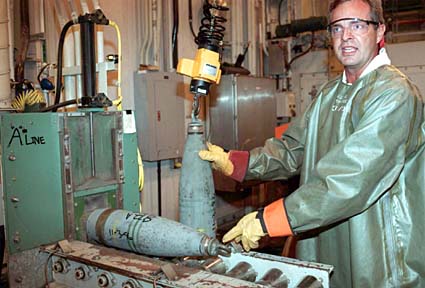
STAR-BULLETIN / 1998
The army says all waste from a decade of chemical weapons disposal on Johnston Atoll has been disposed. Ken Brooks set a live sarin agent projectile on the belt to begin the process of demilitarizing the weapon on Johnston Atoll in 1998.
Army finishes Johnston
Atoll waste cleanup
First, they had to clean up the mess. Then they had to clean up the mess they made cleaning up the mess.
Disposing of chemical weapons can be dirty business, but the Army says all secondary waste from a decade of chemical weapons disposal on Johnston Atoll has been safely incinerated on the isolated Pacific island about 825 miles southwest of Hawaii.
This includes plastic, paper, wood, sludge, charcoal, concrete, hoses and aluminum left over from destruction of some of the most dangerous chemical weapons ever produced.
"This is a significant accomplishment towards the elimination of chemical weapons," said site manager Gary McCloskey, quoted in a news release from the U.S. Army Chemical Materials Agency, which is responsible for safely storing and destroying America's aging chemical weapons stockpiles on the atoll and at other sites.
McCloskey announced that the Johnston Atoll Chemical Agent Disposal System reached an "important milestone" as it "completed the safe thermal processing of the stored secondary wastes that were generated from the destruction of the chemical agents and weapons."
The material was packed into 4,300 drums and thermally treated in the metal parts furnace on Johnston Atoll, the Army said.
The next step is final closure of the facility and return of the island to its more natural role as a refuge for birds and sea creatures, probably by next year.
McCloskey said the success of the operation shows that similar methods can be used at other chemical weapons stockpile sites on the U.S. mainland, including one near Tooele, Utah.
The Army says independent scientists, Dr. Phil Lobel of Boston University and Elizabeth A. Schreiber of the Ornithological Council, have determined that the environment around the atoll remains healthy, with marine life, seabirds and shorebirds all thriving.
"Extensive monitoring of the individual existing native wildlife species and soil sampling will continue throughout the JACADS closure process," McCloskey said.
The island, considered a key Pacific bird-nesting site, once served as storage facility for rockets, bombs, artillery shells, and mines filled with a nerve agent so powerful that a drop on the skin can kill a person.
Over nearly a decade ending in November 2000, the Army destroyed more than 400,000 chemical munitions and 2,000 tons of chemical agents on the island, unincorporated U.S. territory.
Federal health and environmental agencies are monitoring the closure operations, which are expected to be completed early next year.
The Army plans to turn over the atoll with its remaining structures to the U.S. Air Force, which now owns the island. The Air Force would, in turn, hand it over to the Interior Department to become part of the Johnston Atoll National Wildlife Refuge, established by Congress in 1926, long before the island became home to the deadly arsenal.
By the time chemical weapons disposal began, the 1-square-mile island held about 6 percent of the U.S. chemical weapons arsenal, stored in concrete igloos.
